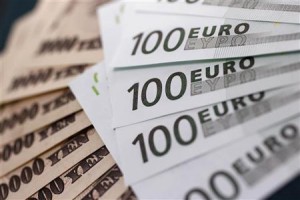 Friday’s trade saw EUR/JPY within the range of 148.25-149.51. The pair closed at 148.27, gaining 0.01% on a daily basis and 0.29% for the whole week.
Friday’s trade saw EUR/JPY within the range of 148.25-149.51. The pair closed at 148.27, gaining 0.01% on a daily basis and 0.29% for the whole week.
Fundamentals
Euro zone
German industrial output
Germanys seasonally adjusted index of industrial production probably fell 0.2% in October compared to a month ago, according to market expectations, following a 1.4% expansion in September. Annualized industrial output contracted 0.1% in September, after another 1.9% decline in August. The index reflects the change in overall inflation-adjusted value of output in sectors such as manufacturing, mining and utilities. In case industrial output shrank more than anticipated, this would mount selling pressure on the euro. Destatis is to publish the official data at 7:00 GMT on Monday.
Sentix Investor Sentiment
Confidence among investors in the Euro zone probably continued to worsen during the current month, with the corresponding index coming in at a reading of -13.5. In November it stood at -11.87. If so, this would be the fourth consecutive month, during which the gauge occupied negative territory. The index is based on results from the SENTIX survey, one of the most prominent surveys, reflecting investors’ opinion in Germany. It encompasses 2 800 respondents, with 510 of them being institutional investors. Respondents present their expectations regarding ten different markets for a period of one and six months. Readings above zero indicate that respondents were predominantly optimistic, while readings below zero show pessimism. Lower-than-expected readings would have a bearish effect on the common currency. The official index value is due out at 9:30 GMT.
ECB Draghi remarks
At the press conference on Thursday European Central Bank President Mario Draghi noted that bank policy makers would wait until early next year in order to determine whether Euro area economy is in need of additional monetary stimulus.
ECB Governing Council expects to take into consideration a proposal to widen the banks asset purchases, meaning the inclusion of sovereign debt, at the upcoming policy meeting on January 22nd, Bloomberg reported.
Japan
Gross Domestic Product
The final estimate of Japans annualized Gross Domestic Product (GDP) probably confirmed the preliminary estimate, pointing to a 1.6% contraction during the third quarter of the year, as reported on November 16th. In Q2 economy shrank at an annualized pace of 7.3%, or the largest decline since Q4 2008, when the nations GDP contracted 15.2%. According to the preliminary GDP report, the rise in public demand and net exports were not enough to neutralize a drop in private demand in Q3. Private demand in Japan fell 0.9%, slicing 0.7 percentage point from the growth. Private consumption, which accounts for almost 60% of the economy, increased 0.4%, an indication that an increase in Japans sales tax to 8% from 5% in April continued causing an adverse influence on activity. Public demand rose 0.7%, adding 0.2% to the growth, according to Japans Cabinet Office.
In case economy contracted at a larger-than-anticipated annual rate, this would have a bearish effect on the yen. The final GDP data is expected at 23:50 GMT on Sunday (December 7th).
Further yen weakness?
Nomura Holdings Inc., the most-accurate predictor of yens movement in the market, expects a 4-percent drop of the yen against the US dollar, with USD/JPY testing the 125 area by the end of 2015. The pair traded in that zone back in 2002. Nomura states that Bank of Japans policy, not politics, will be the main driving force behind the yen. According to the company, Japans central bank will probably expand monetary stimulus again in 2015. At the same time, the Federal Reserve Bank intends to raise borrowing costs and bolster demand for the US dollar for the first time since 2006.
”Monetary policy will be going in polar-opposite directions,” Tomo Kinoshita, the chief economist at Nomura, the largest brokerage in Japan, said by phone from Tokyo on Thursday, cited by Bloomberg News. ”That will keep the scenario for a weaker yen intact.”
Meanwhile, polls published by five Japanese newspapers – Nikkei, Asahi, Yomiuri, Sankei and Mainichi on Thursday revealed that the coalition led by the Prime Minister Shinzo Abe’s Liberal Democratic Party will probably maintain the two-thirds majority in the lower house. The party would secure 300 out of 475 seats, which would allow it to override decisions made by the upper-house.
Another survey, conducted by the Nikkei newspaper earlier in the week, showed that the Japanese government had the approval of 42% of the population, or a decrease by 2 points in comparison with the poll on November 24th.
Pivot Points
According to Binary Tribune’s daily analysis, the central pivot point for the pair is at 148.68. In case EUR/JPY manages to breach the first resistance level at 149.10, it will probably continue up to test 149.94. In case the second key resistance is broken, the pair will probably attempt to advance to 150.36.
If EUR/JPY manages to breach the first key support at 147.84, it will probably continue to slide and test 147.42. With this second key support broken, the movement to the downside will probably continue to 146.58.
The mid-Pivot levels for Monday are as follows: M1 – 147.00, M2 – 147.63, M3 – 148.26, M4 – 148.89, M5 – 149.52, M6 – 150.15.
In weekly terms, the central pivot point is at 148.27. The three key resistance levels are as follows: R1 – 149.51, R2 – 150.75, R3 – 151.99. The three key support levels are: S1 – 147.03, S2 – 145.79, S3 – 144.55.





